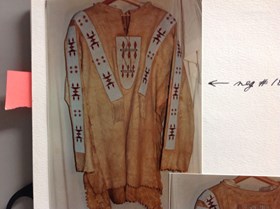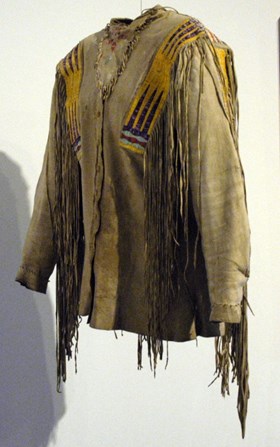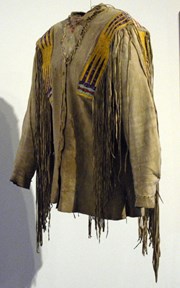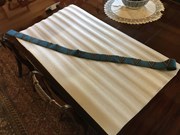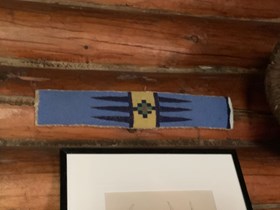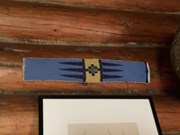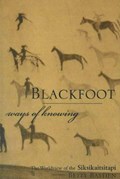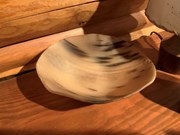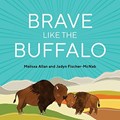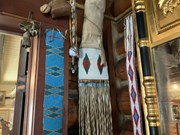Narrow Results By
- Webstad, Phyllis 2
- Adese, Jennifer 1
- Allan, Melissa 1
- Bastien, Betty 1
- Black, Liza 1
- Blondin, Walter; Blondin, George; Goose, Leanne; Mountain, Antoine; Stewart, Sarah; Yakeleya, Raymond; and Dene Elders; foreword by Blondin, Walter. 1
- Brown, Chester 1
- Carlson-Manathara, Elizabeth and Rowe, Gladys 1
- Delehanty Pearkes, Eileen 1
- Dion, Susan D. 1
- Duncan, Dayton and Burns, Ken 1
- Graham, Mary 1
- Date
- 1885 – 1900
- Material
- skin, deer; glass; fibre
- Catalogue Number
- 103.05.1023
- Description
- Morning coat length bead-adorned shirt, fringed, notched collar with thongs, slits from bottom to armpits with thong ties, notched bottom edge and sleeves, bead pattern, white background, open geometric design with triangles, diamonds, and crosses of red, mauve and green, strips on sleeves from bre…
1 image
- Title
- Beaded Shirt
- Date
- 1885 – 1900
- Material
- skin, deer; glass; fibre
- Dimensions
- 55.0 x 89.0 cm
- Description
- Morning coat length bead-adorned shirt, fringed, notched collar with thongs, slits from bottom to armpits with thong ties, notched bottom edge and sleeves, bead pattern, white background, open geometric design with triangles, diamonds, and crosses of red, mauve and green, strips on sleeves from breast over shoulder to lower back (canvas backed), fringes on ends, buckskin backed swatches, solarplexus, back (fringed).
- Subject
- Indigenous
- clothing
- regalia
- beadwork
- Credit
- Gift of Pearl Evelyn Moore, Banff, 1969
- Catalogue Number
- 103.05.1023
Images
This material is presented as originally created; it may contain outdated cultural descriptions and
potentially offensive content.
Read more.
- Date
- 1880 – 1900
- Material
- skin; quill ; fibre
- Catalogue Number
- 103.05.1024
- Description
- Fringed buckskin shirt with porcupine quills, collarless, rounded beige buttons, (12) green and pink floral quill gorget, same on back attached at neck, quill strips, yellow background, opposed long purple spear shapes, above and below wavy lines, turquoise, purple, red, yellow, with long buckskin …
1 image
- Title
- Beaded Shirt
- Date
- 1880 – 1900
- Material
- skin; quill ; fibre
- Dimensions
- 52.5 x 81.8 cm
- Description
- Fringed buckskin shirt with porcupine quills, collarless, rounded beige buttons, (12) green and pink floral quill gorget, same on back attached at neck, quill strips, yellow background, opposed long purple spear shapes, above and below wavy lines, turquoise, purple, red, yellow, with long buckskin fringes on edges, strips on sleeves and from breast across shoulder to lower back, sleeves cuffed with notched edge.
- Subject
- Indigenous
- regalia
- clothing
- quillwork
- Credit
- Gift of Unknown, 1968
- Catalogue Number
- 103.05.1024
Images
This material is presented as originally created; it may contain outdated cultural descriptions and
potentially offensive content.
Read more.
- Date
- 1880
- Material
- skin; glass
- Catalogue Number
- 103.01.0022
- Description
- Two long strips of beaded leather sewn together end to end. The pattern on the stip is a medium blue background with orange Vs outlined in black along its length.
1 image
- Title
- Beaded Trim
- Date
- 1880
- Material
- skin; glass
- Dimensions
- 7.5 x 196.0 cm
- Description
- Two long strips of beaded leather sewn together end to end. The pattern on the stip is a medium blue background with orange Vs outlined in black along its length.
- Credit
- Gift of Pearl Evelyn Moore, Banff, 1979
- Catalogue Number
- 103.01.0022
Images
This material is presented as originally created; it may contain outdated cultural descriptions and
potentially offensive content.
Read more.
- Date
- 1880 – 1930
- Material
- skin; glass
- Catalogue Number
- 103.01.0029
- Description
- A strip of beadwork sewn together in rows completely covering a hide strip. The design features a medium blue background with a yellow square in the middle, outlined with dark blue, and three long pointed shapes at either side. A small red square at the centre of the yellow square is surrounded by…
1 image
- Title
- Beaded Trim
- Date
- 1880 – 1930
- Material
- skin; glass
- Dimensions
- 8.5 x 46.0 cm
- Description
- A strip of beadwork sewn together in rows completely covering a hide strip. The design features a medium blue background with a yellow square in the middle, outlined with dark blue, and three long pointed shapes at either side. A small red square at the centre of the yellow square is surrounded by four green squares and then eight dark blue squares. One end of the strip has a white and dark blue scalloped band.
- Credit
- Gift of Pearl Evelyn Moore, Banff, 1979
- Catalogue Number
- 103.01.0029
Images
This material is presented as originally created; it may contain outdated cultural descriptions and
potentially offensive content.
Read more.
Beyond the orange shirt story
https://archives.whyte.org/en/permalink/catalogue25692
- Medium
- Library - Book (including soft-cover and pamphlets)
- Published Date
- 2021
- Author
- Webstad, Phyllis
- Publisher
- Medicine Wheel Publishing
- Call Number
- 07.2 W39b
- Author
- Webstad, Phyllis
- Publisher
- Medicine Wheel Publishing
- Published Date
- 2021
- Physical Description
- 102 pages
- Abstract
- Beyond the Orange Shirt Story is a unique collection of truths that articulate the lives and experiences of some Residential School Survivors and their families. Compiled by Phyllis Webstad, Residential School Survivor and Founder of the Orange Shirt Day movement, this book will give readers an up-close look at what life was like for many Survivors -- before, during, and after their Residential School experiences. These personal Survivor accounts, relayed in a number of one on one interviews, are authentically shared in their own voices.-- Provided by Publisher
- Contents
- 1. Phyllis Webstad -- 2. Suzanne Edward Jim (Phyllis Webstad's great-grandmother) -- 3. Helena (Lena) Jack (Nee Billy) (Phyllis Webstad's grandmother) -- 4. Rose Wilson Nee Jack (Phyllis Webstad's mother) -- 5. Theresa Jack (Phyllis Webstad's auntie) -- 6. Hazel Agness Jack (Phyllis Webstad's auntie) -- 7. Jeremy Boston (Phyllis Webstad's son) -- 8. Mason and Blake Murphy (Phyllis Webstad's grandchildren) -- 9. Lynn Eberts (Phyllis Webstad's elementary school teacher) -- 10. Photos of Phyllis Webstad's family -- 11. St. Joseph's Mission Residential School.
- ISBN
- 9781989122754
- Accession Number
- P2022.14
- Call Number
- 07.2 W39b
- Collection
- Archives Library
This material is presented as originally created; it may contain outdated cultural descriptions and
potentially offensive content.
Read more.
Blackfoot ways of knowing : the worldview of the Siksikaitsitapi
https://archives.whyte.org/en/permalink/catalogue26211
- Medium
- Library - Book (including soft-cover and pamphlets)
- Published Date
- 2023
- Author
- Bastien, Betty
- Publisher
- Calgary : University of Calgary Press
- Edition
- 9th printing
- Call Number
- 07.2 B29b
- Author
- Bastien, Betty
- Responsibility
- Ju¨rgen W. Kremer, editor ; Duane Mistaken Chief, language consultant.
- Edition
- 9th printing
- Publisher
- Calgary : University of Calgary Press
- Published Date
- 2023
- Physical Description
- xx, 235 pages : illustrations, portraits ; 23 cm
- Subjects
- Blackfoot
- Siksikaitsitapi
- Indigenous
- Indigenous Culture
- Indigenous Customs
- Indigenous People
- Indigenous Traditions
- Indigenous Language
- Abstract
- The worldview of the Siksikaitsitapi is a journey into the heart and soul of Blackfoot culture. In sharing her personal story of coming home to reclaim her identity within that culture, Betty Bastien offers us a gateway into traditional Blackfoot ways of understanding and experiencing the world. As a scholar and researcher, Bastien is also able to place Blackfoot tradition within the context of knowledge building among indigenous peoples generally, and within an historical context of precarious survival amid colonial displacement and cultural genocide. -- From back cover
- Contents
- Context -- Introduction -- Innahkootaitsinnika'topi -- History of the Blackfoot-speaking tribes -- Introductory remarks -- Iitotasimahpi Iimitaiks -- The era of the dog or the time of the ancestors (Pre-eighteenth century) -- Ao'ta'sao'si Ponokaomita -- the era of the horse (eighteeneth century to 1880) -- Ao'maopao'si -- from when we settled in one place (1880) to today -- Cultural destruction -- policies of ordinary genocide -- Tribal protocol and affirmative inquiry -- Niinohkanistssksinipi -- Speaking personally -- Traditional knowledge in academe -- Cultural affirmation -- Protocol of affirmative inquiry -- Affirmation of indigenous knowledge -- Kakyosin -- traditional knowledge -- Kiitomohpiipotoko -- ontological responsibilities -- Siksikaitsitapi ways of knowing -- epistemology -- Knowledge is coming to know Ihtsipaitapiiyo'pa -- Kakyosin/Mokaksin -- Indigenous learning -- Niisi'powahsinni-language -- Aipommotsspistsi -- transfers -- Kaaahsinnooniksi -- grandparents -- Conclusion: renewal of ancestral responsibilities as antidote to genocide -- Deconstructing the colonized mind -- Eurocentred and Niitsitapi identity -- Reflections and implications.
- ISBN
- 9781552381090
- Accession Number
- P2023.25
- Call Number
- 07.2 B29b
- Collection
- Archives Library
This material is presented as originally created; it may contain outdated cultural descriptions and
potentially offensive content.
Read more.
Blood memory : the tragic decline and improbable resurrection of the American Buffalo
https://archives.whyte.org/en/permalink/catalogue26204
- Medium
- Library - Book (including soft-cover and pamphlets)
- Published Date
- 2023
- Author
- Duncan, Dayton and Burns, Ken
- Publisher
- New York : Alfred A. Knopf
- Call Number
- 08 D91b
- Publisher
- New York : Alfred A. Knopf
- Published Date
- 2023
- Physical Description
- xvi, 329 pages : illustrations (chiefly color) ; 24 cm
- Subjects
- Buffalo
- Pablo-Allard buffalo round-up
- Conservation
- Indigenous
- Colonialism
- Environment
- Ecology
- Abstract
- The epic story of the buffalo in America, from prehistoric times to today--a moving and beautifully illustrated work of natural history. The American buffalo--our nation's official mammal-is an improbable, shaggy beast that has found itself at the center of many of our most mythic and sometimes heartbreaking tales. The largest land animals in the Western Hemisphere, they are survivors of a mass extinction that erased ancient species that were even larger. For nearly 10,000 years, they evolved alongside Native people who weaved them into every aspect of daily life; relied on them for food, clothing, and shelter; and revered them as equals. Newcomers to the continent found the buffalo fascinating at first, but in time they came to consider them a hindrance to a young nation's expansion. And in the space of only a decade they were slaughtered by the millions for their hides, with their carcasses left to rot on the prairies. Then, teetering on the brink of disappearing from the face of the earth, they would be rescued by a motley collection of Americans, each of them driven by different--and sometimes competing--impulses. This is the rich and complicated story of a young republic's heedless rush to conquer a continent, but also of the dawn of the conservation era--a story of America at its very best and worst -- Provided by publisher.
- Contents
- Part 1: The Trail to Extinction -- The Buffalo and the People -- Strangers -- Omen in the Skies -- The Iron Horse -- Kills Tomorrow -- Part 2: Back From the Brink -- A Death Wind for My People -- Just in the Nick of Time -- Changes of Heart -- Ghosts -- The Last Refuge -- Blood Memory -- Big Medicine.
- Notes
- Dayton Duncan ; based on a documentary film by Ken Burns ; written by Dayton Duncan ; with an introduction by Ken Burns ; picture research by Emily Mosher and Susan Shumaker ; design by Maggie Hinders.
- Whyte Museum archival collections utilized.
- ISBN
- 9780593537343
- Accession Number
- P2023.25
- Call Number
- 08 D91b
- Collection
- Archives Library
This material is presented as originally created; it may contain outdated cultural descriptions and
potentially offensive content.
Read more.
- Date
- 1885 – 1925
- Material
- horn
- Catalogue Number
- 104.20.0237
- Description
- Irregular shaped bowl made by boiling and scraping the horn of a bighorn sheep. Flattened at bottom to form steady base. Translucent natural colour with lines of dark brown showing in patches along grain.
1 image
- Title
- Bowl
- Date
- 1885 – 1925
- Material
- horn
- Dimensions
- 6.2 x 16.1 x 19.0 cm
- Description
- Irregular shaped bowl made by boiling and scraping the horn of a bighorn sheep. Flattened at bottom to form steady base. Translucent natural colour with lines of dark brown showing in patches along grain.
- Subject
- Indigenous
- households
- Credit
- Gift of Catharine Robb Whyte, O. C., Banff, 1979
- Catalogue Number
- 104.20.0237
Images
This material is presented as originally created; it may contain outdated cultural descriptions and
potentially offensive content.
Read more.
Braided learning : illuminating indigenous presence through art and story
https://archives.whyte.org/en/permalink/catalogue25539
- Medium
- Library - Book (including soft-cover and pamphlets)
- Published Date
- 2022
- Author
- Dion, Susan D.
- Publisher
- Vancouver, B.C. : Purich Books
- Call Number
- 07.2 D62b
- Author
- Dion, Susan D.
- Publisher
- Vancouver, B.C. : Purich Books
- Published Date
- 2022
- Physical Description
- 275 pages
- Abstract
- The Truth and Reconciliation Commission and Indigenous activism have made many Canadians uncomfortably aware of how little they know about First Nations, Métis, and Inuit peoples. In Braided Learning, Lenape-Potawatomi scholar and educator Susan Dion shares her approach to learning and teaching about Indigenous histories and perspectives. Métis leader Louis Riel illuminated the connection between creativity and identity in his declaration, “My people will sleep for a hundred years, but when they awake, it will be the artists who give them their spirits back.” Using the power of stories and artwork, Dion offers respectful ways to address challenging topics including treaties, the Indian Act, the Sixties Scoop, land claims, resurgence, the drive for self-determination, and government policies that undermine language, culture, and traditional knowledge systems. Braided Learning draws on Indigenous knowledge and world views to explain perspectives that are often missing from the national narrative. This generous work is an invaluable resource for Canadians trying to make sense of a difficult past, decode unjust conditions in the present, and work toward a more equitable future. -- Provided by publisher
- Contents
- Introduction: Indigenous Presence ; Requisites for Reconciliation ; Seeing Yourself in Relationship with Settler Colonialism ; The Historical Timeline: Refusing Absence, Knowing Presence, and Being Indigenous ; Learning from Contemporary Indigenous Artists ; The Braiding Histories Stories ; Conclusion: Wuleelham - Make Good Tracks ; Glossary and Additional Resources: Making Connections, Extending Learning
- ISBN
- 9780774880794
- Accession Number
- P2022.04
- Call Number
- 07.2 D62b
- Collection
- Archives Library
This material is presented as originally created; it may contain outdated cultural descriptions and
potentially offensive content.
Read more.
Braiding sweetgrass for young adults : indigenous wisdom, scientific knowledge, and the teachings of plants
https://archives.whyte.org/en/permalink/catalogue25691
- Medium
- Library - Book (including soft-cover and pamphlets)
- Published Date
- 2022
- Author
- Wall Kimmerer, Robin
- Publisher
- Minneapolis : Zest Books
- Call Number
- 07.2 W15s
- Author
- Wall Kimmerer, Robin
- Responsibility
- Adapted by Monique Gray Smith ; Illustrations by Nicole Neidhardt
- Publisher
- Minneapolis : Zest Books
- Published Date
- 2022
- Physical Description
- 303 pages : illustrations ; 22 cm
- Abstract
- Botanist Robin Wall Kimmerer's best-selling book Braiding Sweetgrass is adapted for a young adult audience by children's author Monique Gray Smith, bringing Indigenous wisdom, scientific knowledge, and the lessons of plant life to a new generation.-- Provided by publisher.
- Contents
- Meeting sweetgrass. An invitation to remember ; Skywoman falling ; Wiingaashk -- Planting sweetgrass. The council of pecans ; The gift of strawberries ; An offering ; Asters and goldenrod -- Tending sweetgrass. Maple sugar moon ; Witch hazel ; Allegiance to gratitude -- Picking sweetgrass.Epiphany in the beans ; The three sisters ; Wisgaak Gokpenagen : a black ash basket ; Mishkos Kenomagwen : the teachings of grass ; Maple nation : a citizenship guide ; The honorable harvest -- Braiding sweetgrass. In the footsteps of Nanabozho : becoming indigenous to place ; Sitting in a circle ; Burning cascade head ; Putting down roots ; Old-growth children -- Burning sweetgrass. Windigo footprints People of corn, people of light ; Shkitagen : People of the seventh fire ; Defeating Windigo.
- ISBN
- 9781728458991
- Accession Number
- P2023.03
- Call Number
- 07.2 W15s
- Collection
- Archives Library
This material is presented as originally created; it may contain outdated cultural descriptions and
potentially offensive content.
Read more.
Brave like the buffalo
https://archives.whyte.org/en/permalink/catalogue26206
- Medium
- Library - Book (including soft-cover and pamphlets)
- Published Date
- 2023
- Author
- Allan, Melissa
- Publisher
- Victoria, BC : Rocky Mountain Books
- Call Number
- 07.2 Al5b
- 07.2 Al5b reference copy
- Author
- Allan, Melissa
- Responsibility
- Illustrated by Jadyn Fischer-McNab
- Publisher
- Victoria, BC : Rocky Mountain Books
- Published Date
- 2023
- Subjects
- Children
- Buffalo
- Wildlife
- Indigenous
- Indigenous People
- Cree
- Abstract
- Brave Like the Buffalo is a children’s book with a message that will inspire all readers to face the storms in their life with the help of their support systems and with a brave mindset. Baby buffalo is surprised and scared when a storm on the prairies passes through. Mama buffalo puts on a brave face and demonstrates how to use courage and bravery to get through the literal and metaphorical storms we may face in life. Written by Melissa Allan and illustrated by Cree illustrator Jadyn Fischer-McNab, this story uses a powerful animal, the buffalo, as a symbolic message and connection to Indigenous ways of knowing and being that helps to create a wonderful narrative rich with Indigenous ties and a heartwarming message around facing adversity. Brave Like the Buffalo is intended for audiences aged 4-8, to be used educationally as a way to intertwine Indigenous ways of knowing and being through story. -- From publisher
- ISBN
- 9781771606448
- Accession Number
- P2023.25
- Call Number
- 07.2 Al5b
- 07.2 Al5b reference copy
- Location
- Reference copy located in Reading Room
- Collection
- Archives Library
This material is presented as originally created; it may contain outdated cultural descriptions and
potentially offensive content.
Read more.
Brotherhood to nationhood : George Manuel and the making of the modern indian movement
https://archives.whyte.org/en/permalink/catalogue25528
- Medium
- Library - Book (including soft-cover and pamphlets)
- Published Date
- 2020
- Author
- McFarlane, Peter and Manuel, Doreen
- Publisher
- Toronto : Between the Lines
- Call Number
- 07.2 M16a
- Publisher
- Toronto : Between the Lines
- Published Date
- 2020
- Physical Description
- xxvi, 311 pages : illustrations ; 23 cm
- Subjects
- Indigenous
- History
- History-Canada
- Colonialism
- Politics
- Abstract
- George Manuel was the strategist and visionary behind the modern Indigenous movement in Canada. A three-time Nobel Peace Prize nominee, he laid the groundwork for what would become the Assembly of First Nations and was the founding president of the World Council of Indigenous Peoples. Authors Peter McFarlane and Doreen Manuel follow him on a riveting journey from his childhood on a Shuswap reserve through three decades of fierce and dedicated activism. In these pages, an all-new foreword by celebrated Mi'kmaq lawyer and activist Pam Palmater is joined by an afterword from Manuel's granddaughter, land defender Kanahus Manuel. This edition features new photos and previously untold stories of the pivotal roles that the women of the Manuel family played--and continue to play--in the battle for Indigenous rights.
- ISBN
- 9781771135108
- Accession Number
- P2021.02
- Call Number
- 07.2 M16a
- Collection
- Archives Library
This material is presented as originally created; it may contain outdated cultural descriptions and
potentially offensive content.
Read more.
Bucking conservatism : alternative stories of Alberta from the 1960s and 1970s
https://archives.whyte.org/en/permalink/catalogue25529
- Medium
- Library - Book (including soft-cover and pamphlets)
- Published Date
- 2021
- Publisher
- Edmonton, Alberta : AU Press
- Call Number
- 08.1 B38b
- Responsibility
- Edited by Leon Crane Bear, Larry Hannant, and Karissa Robyn Patton
- Publisher
- Edmonton, Alberta : AU Press
- Published Date
- 2021
- Physical Description
- xxx, 333 pages; 24 cm
- Subjects
- Politics
- History of Alberta
- Indigenous
- Feminism
- Activism
- Resistance
- Heteropatriarchy
- Environmentalism
- Abstract
- Highlights the individuals and groups who challenged Alberta's conservative status quo in the 1960s and 70s. Drawing on archival records, newspaper articles, police reports, and interviews, the contributors examine Alberta's history through the eyes of Indigenous activists protesting discriminatory legislation and unfulfilled treaty obligations, women and lesbian and gay persons standing up to the heteropatriarchy, student activists seeking to forge a new democracy, and anti-capitalist environmentalists demanding social change. This book uncovers the lasting influence of Alberta's noncomformists--those who recognized the need for dissent in a province defined by wealth and right-wing politics--and poses thought-provoking questions for contemporary activists. -- Provided by publisher
- Contents
- Indian Status as the Foundation of Justice / Leon Crane Bear ; Teaching It Our Way: Blue Quills and the Demand for Indigenous Educational Autonomy / Tarisa Dawn Little ; "We are on the outside looking in [. . .]. But we are still Indians": Alberta Indigenous Women Fighting for Status Rights, 1968-85 / Corinne George ; Fed Up with Status Quo: Alberta Women's Groups Challenge Maternalist Ideology and Secure Provincial Funding for Daycare, 1964-71 ; Gay Liberation in Conservative Calgary / Nevena Ivanovic, Kevin Allen, and Larry Hannan ; Contraception, Community, and Controversy: The Lethbridge Birth Control and Information Centre, 1972-78 / Karissa Robyn Patton ; "Ultra Activists" in a "Very Closeted Place": The Early Years of Edmonton's Gay Alliance Toward Equality, 1972-77 / Erin Gallagher-Cohoon ; Daring to Be Left in Social Credit Alberta: Recollections of a Young Democratic Party Activist in the 1960s / Ken Novakowski ; Socialist Survival: The Woodsworth-Irvine Socialist Fellowship and the Preservation of Radical Thought in Alberta / Mack Penner ; Learning Marxism from Tom Flanagan: Left-Wing Activism at the University of Calgary in the Late 1960s and Early 1970s / Larry Hamnant ; Drop In, Hang Out, and Crash: Outreach Programs for Transient Youth and War Resisters in Edmonton / Baldwin Reichwein and PearlAnn Reichwein ; Solidarity on the Cricket Pitch: Confronting South African Apartheid in Edmonton / Larry Hannant ; From Nuclear Disarmament to Raging Granny: A Recollection of Peace Activism and Environmental Advocacy in the 1960s and 1970s / Louise Swift ; The Mill Creek Park Movement and Citizen Activism in Edmonton, 1964-75 / PearlAnn Reichwein and Jan Olson ; "A Lot of Heifer-Dust": Alberta Maverick Marion Nicoll and Abstract Art / Jennifer E. Salahub ; Land and Love in the Rockies: The Poetic Politics of Sid Marty and Headwaters / PearlAnn Reichwein ; Death of a Delta / Tom Radford ; Conclusion: Bucking Conservatism, Then and Now / Karissa Robyn Patton and Mack Penner
- ISBN
- 9781771992572
- Accession Number
- P2021.03
- Call Number
- 08.1 B38b
- Collection
- Archives Library
This material is presented as originally created; it may contain outdated cultural descriptions and
potentially offensive content.
Read more.
- Date
- 1880 – 1940
- Material
- skin; glass; grass
- Catalogue Number
- 109.02.0007
- Description
- A long pouch of deerskin with a four pointed opening which folds over to form a pointed flap where a tying thong is attached. The edge of the opening is beaded. There is long leather fringe along the bottom bottom edge that has bugle beads strung close to the music. The bottom third of the bag is…
1 image
- Title
- Calumet Bag
- Date
- 1880 – 1940
- Material
- skin; glass; grass
- Dimensions
- 16.0 x 74.0 cm
- Description
- A long pouch of deerskin with a four pointed opening which folds over to form a pointed flap where a tying thong is attached. The edge of the opening is beaded. There is long leather fringe along the bottom bottom edge that has bugle beads strung close to the music. The bottom third of the bag is completely beaded with a white background and two red and blue diamond shapes.
- Subject
- Indigenous
- Stoney
- Kootenay
- beadwork
- smoking
- ceremonial
- Ktunaxa
- Credit
- Gift of Pearl Evelyn Moore, Banff, 1979
- Catalogue Number
- 109.02.0007
Images
This material is presented as originally created; it may contain outdated cultural descriptions and
potentially offensive content.
Read more.
Carrying the burden of peace : reimagining Indigenous masculinities through story
https://archives.whyte.org/en/permalink/catalogue25728
- Medium
- Library - Book (including soft-cover and pamphlets)
- Published Date
- 2021
- Author
- McKegney, Sam
- Publisher
- Regina, Saskatchewan, Canada : University of Regina Press
- Call Number
- 07.2 M19c
- Author
- McKegney, Sam
- Publisher
- Regina, Saskatchewan, Canada : University of Regina Press
- Published Date
- 2021
- Physical Description
- xxxiii, 263 pages : illustrations ; 24 cm
- Subjects
- Indigenous
- Indigenous Culture
- Indigenous Customs
- Indigenous Peoples
- Indigenous Traditions
- Masculinity
- Canada
- History
- Abstract
- Through rigorous engagement with Indigenous literary art, Carrying the Burden of Peace highlights the decolonial potential of Indigenous masculinities. Can a critical examination of Indigenous masculinities be an honour song--one that celebrates rather than pathologizes; one that seeks diversity and strength; one that overturns heteropatriarchy without centering settler colonialism? Can a critical examination of Indigenous masculinities even be creative, inclusive, erotic? Carrying the Burden of Peace answers affirmatively. Countering the perception that masculinity has been so contaminated as to be irredeemable, the book explores Indigenous literary art for understandings of masculinity that exceed the impoverished inheritance of colonialism. Carrying the Burden of Peace weaves together stories of Indigenous life, love, eroticism, pain, and joy to map the contours of diverse, empowered, and non-dominant Indigenous masculinities. It is from here that a more balanced world may be pursued. -- Provided by publisher.
- Contents
- Indigenous masculinities and story -- Shame and deterritorialization -- Journeying back to the body -- De(f/v)iant generosity: gender and the gift -- Masculinity and kinship -- Naked and dreaming forward: a conclusion.
- ISBN
- 9780889777934
- Accession Number
- P2023.15
- Call Number
- 07.2 M19c
- Collection
- Archives Library
This material is presented as originally created; it may contain outdated cultural descriptions and
potentially offensive content.
Read more.
- Date
- 1880 – 1900
- Material
- metal; wood
- Catalogue Number
- 105.03.0017
- Description
- Hand bell with wooden handle and brass collar and bell. Brass clapper suspended on iron hook. Collar at base of wooden handle was riveted but has loosened. Clapper marks inside bell rim.
1 image
- Title
- Church Bell
- Date
- 1880 – 1900
- Material
- metal; wood
- Dimensions
- 21.5 cm
- Description
- Hand bell with wooden handle and brass collar and bell. Brass clapper suspended on iron hook. Collar at base of wooden handle was riveted but has loosened. Clapper marks inside bell rim.
- Credit
- Gift of Catharine Robb Whyte, O. C., Banff, 1979
- Catalogue Number
- 105.03.0017
Images
This material is presented as originally created; it may contain outdated cultural descriptions and
potentially offensive content.
Read more.
- Date
- 1880 – 1910
- Material
- stone; wood; skin; metal; hair, buffalo; feather, eagle; sinew
- Catalogue Number
- 104.06.0004
- Description
- A war club/pony club made of an oval-shaped stone attached to a leather-covered stick handle with a leather strap. The leather strap has a tuft of eagle down at its end. The end of the handle has a leather loop with a bunch of long dark bison hair tied together at one end.
1 image
- Title
- Club
- Date
- 1880 – 1910
- Material
- stone; wood; skin; metal; hair, buffalo; feather, eagle; sinew
- Dimensions
- 55.0 cm
- Description
- A war club/pony club made of an oval-shaped stone attached to a leather-covered stick handle with a leather strap. The leather strap has a tuft of eagle down at its end. The end of the handle has a leather loop with a bunch of long dark bison hair tied together at one end.
- Subject
- Indigenous
- Stoney
- military
- Credit
- Gift of Pearl Evelyn Moore, Banff, 1979
- Catalogue Number
- 104.06.0004
Images
This material is presented as originally created; it may contain outdated cultural descriptions and
potentially offensive content.
Read more.
Decolonizing sport
https://archives.whyte.org/en/permalink/catalogue26241
- Medium
- Library - Book (including soft-cover and pamphlets)
- Published Date
- 2023
- Publisher
- Halifax ; Winnipeg : Fernwood Publishing
- Call Number
- 07.2 F77d
- Responsibility
- Edited by Janice Forsyth, Christine O'Bonsawin, Russell Field, and Murray G. Phillips
- Publisher
- Halifax ; Winnipeg : Fernwood Publishing
- Published Date
- 2023
- Physical Description
- xi, 276 pages : illustrations ; 23 cm
- Subjects
- Canada
- History-Canada
- Education
- Sport
- Indigenous
- Indigenous Culture
- Indigenous People
- Indigenous Traditions
- Indigenous Customs
- Abstract
- The path to decolonization is difficult and complex, and can even be contradictory at times, as when an Indigenous community enlists the same corporate sponsor that will destroy its natural environment to provide sport programming for its youth. There is no easy way forward. The Black Lives Matter movement, and their massive followers on social media, propelled forward discussions about the inequities that Covid-19 highlighted with unprecedented momentum. Indigenous people in Canada voiced their concerns in solidarity, calling attention to disparities they faced in everything from impoverished Indigenous health care initiatives to the overrepresentation of Indigenous people in the Canadian justice system, demanding to be heard alongside systemic change. Structural adjustments were afoot, including changes in the professional sport leagues. In both the United States and Canada, people witnessed the toppling of racist sports team names and logos in the spring and summer, not the least of which included the American Washington NFL team (Redskins) and the Canadian Edmonton CFL team (Eskimos). Clearly Indigenous people and their allies saw sport as a part of this desire for social change. This multi-authored collection contributes to that desire by bringing the work of Indigenous and non-Indigenous allied scholars together to explore the history of sport, physical activity, and embodied physical culture in the Indigenous context. Including chapters that address Indigenous topics beyond the political boundaries of Canada, including the US, Australia, New Zealand/Aotearoa, and Kenya, this collection considers questions such as: How can the history of sport (a colonizing practice with European origins) exist in dialogue with Indigenous voices to open up possibilities for reconsidering the history of modern sport? How can Indigenous and anti-oppressive research methodologies/methods inform the study of sport history? What are the ethics and responsibilities associated with conducting an Indigenous sport or recreation history? How can sport history as a discipline be open to the study of traditional land-based recreation? How can the meanings of "sport" be made more inclusive to include a variety of recreational practices? How can sport historians learn from histories of colonization and how can they contribute to a more reciprocal approach to knowledge formation through Indigenous community engagement? How can the discipline of sport history meaningfully support movements of Indigenous resurgence, regeneration, and decolonization? -- Provided by publisher.
- Contents
- Ways of knowing: sport, colonialism, and decolonization / Janice Forsyth, Christine O'Bonsawin, Russell Field -- Beyond competition: an Indigenous perspective on organized sport / Brian Rice -- More than a mascot: how the mascot debate erases Indigenous people in sport / Natalie Welch -- Witnessing painful pasts: understanding images of sports at Canadian Indian residential schools / Taylor McKee and Janice Forsyth -- The absence of Indigenous moving bodies: whiteness and decolonizing sport history / Malcolm MacLean -- # 87: using Wikipedia for sport reconciliation / Victoria Paraschak -- Olympism at face value: the legal feasibility of Indigenous-led Olympic Games / Christine O'Bonsawin -- Canoe racing to fishing guides: sport and settler colonialism in Mi'kma'ki / John Reid -- Transcending colonialism?: rodeos and racing in Lethbridge / Robert Kossuth -- "Men pride themselves on feats of endurance": masculinities and movement cultures in Kenyan running history / Michelle M. Sikes -- Stealing, drinking, and not cooperating: sport and everyday resistance in Aboriginal settlements in Australia / Gary Osmond -- Let's make baseball!: practices of unsettling on the recreational ball diamonds of Tkaronto/Toronto / Craig Fortier and Colin Hastings -- Subjugating and liberating at once: Indigenous sport history as a double-edge sword / Brendan Hokowhitu.
- ISBN
- 9781773636344
- Accession Number
- P2024.02
- Call Number
- 07.2 F77d
- Collection
- Archives Library
This material is presented as originally created; it may contain outdated cultural descriptions and
potentially offensive content.
Read more.
Exactly what I said : translating words and worlds
https://archives.whyte.org/en/permalink/catalogue25707
- Medium
- Library - Book (including soft-cover and pamphlets)
- Published Date
- 2022
- Author
- Yeoman, Elizabeth
- Publisher
- Winnipeg, Manitoba, Canada : University of Manitoba Press
- Call Number
- 07.2 Y4e
- Author
- Yeoman, Elizabeth
- Publisher
- Winnipeg, Manitoba, Canada : University of Manitoba Press
- Published Date
- 2022
- Physical Description
- 276 pages : illustrations, map ; 23 cm
- Subjects
- Indigenous
- Indigenous Culture
- Indigenous Peoples
- Indigenous Traditions
- Language
- Translation
- Abstract
- 'You don't have to use the exact same words.... But it has to mean exactly what I said.' Thus began the ten-year collaboration between Innu elder and activist Tshaukuesh Elizabeth Penashue and Memorial University professor Elizabeth Yeoman that produced the celebrated Nitinikiau Innusi: I Keep the Land Alive, an English-language edition of Penashue's journals, originally written in Innu-aimun during her decades of struggle for Innu sovereignty. Exactly What I Said: Translating Words and Worlds reflects on that collaboration and what Yeoman learned from it. It is about naming, mapping, and storytelling; about photographs, collaborative authorship, and voice; about walking together on the land and what can be learned along the way. Combining theory with personal narrative, Yeoman weaves together ideas, memories, and experiences--of home and place, of stories and songs, of looking and listening--to interrogate the challenges and ethics of translation. Examining what it means to relate whole worlds across the boundaries of language, culture, and history, Exactly What I Said offers an accessible, engaging reflection on respectful and responsible translation and collaboration.-- Provided by publisher.
- Contents
- Introduction -- Mapping -- Walking -- Stories -- Looking -- Signs -- Literacies -- Listening -- Songs -- Wilderness
- ISBN
- 9780887552731
- Accession Number
- P2023.07
- Call Number
- 07.2 Y4e
- Collection
- Archives Library
This material is presented as originally created; it may contain outdated cultural descriptions and
potentially offensive content.
Read more.
The geography of memory : reclaiming the cultural, natural and spiritual history of the Snayackstx (Sinixt) First people
https://archives.whyte.org/en/permalink/catalogue25654
- Medium
- Library - Book (including soft-cover and pamphlets)
- Published Date
- 2022
- Author
- Delehanty Pearkes, Eileen
- Publisher
- Calgary : Rocky Mountain Books
- Call Number
- 07.2 D37a
- Author
- Delehanty Pearkes, Eileen
- Publisher
- Calgary : Rocky Mountain Books
- Published Date
- 2022
- Physical Description
- 1 volume : illustrations (black and white) ; 23 cm
- Abstract
- This compact book records a quest for understanding, to find the story behind the Snayackstx (Sinixt) First Nation. Known in the United States as the Arrow Lakes Indians of the Colville Confederated Tribes, the tribe lived along the upper Columbia River and its tributaries for thousands of years. In a story unique to First Nations in Canada, the Canadian federal government declared them “extinct” in 1956, eliminating with the stroke of a pen this tribe’s ability to legally access 80 per cent of their trans-boundary traditional territory. Part travelogue, part cultural history, the book details the culture, place names, practices, and landscape features of this lost tribe of British Columbia, through a contemporary lens that presents all readers with an opportunity to participate in reconciliation. -- From publisher
- ISBN
- 9781771605212
- Accession Number
- P2022.14
- Call Number
- 07.2 D37a
- Collection
- Archives Library
This material is presented as originally created; it may contain outdated cultural descriptions and
potentially offensive content.
Read more.

